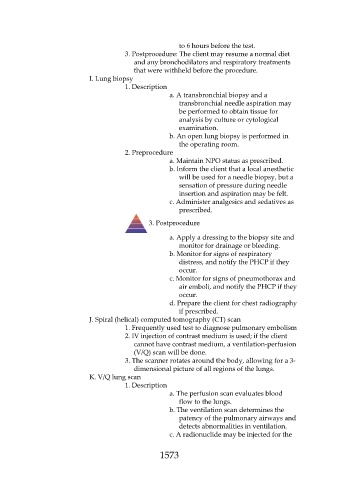Page 1573 - Saunders Comprehensive Review For NCLEX-RN
P. 1573
to 6 hours before the test.
3. Postprocedure: The client may resume a normal diet
and any bronchodilators and respiratory treatments
that were withheld before the procedure.
I. Lung biopsy
1. Description
a. A transbronchial biopsy and a
transbronchial needle aspiration may
be performed to obtain tissue for
analysis by culture or cytological
examination.
b. An open lung biopsy is performed in
the operating room.
2. Preprocedure
a. Maintain NPO status as prescribed.
b. Inform the client that a local anesthetic
will be used for a needle biopsy, but a
sensation of pressure during needle
insertion and aspiration may be felt.
c. Administer analgesics and sedatives as
prescribed.
3. Postprocedure
a. Apply a dressing to the biopsy site and
monitor for drainage or bleeding.
b. Monitor for signs of respiratory
distress, and notify the PHCP if they
occur.
c. Monitor for signs of pneumothorax and
air emboli, and notify the PHCP if they
occur.
d. Prepare the client for chest radiography
if prescribed.
J. Spiral (helical) computed tomography (CT) scan
1. Frequently used test to diagnose pulmonary embolism
2. IV injection of contrast medium is used; if the client
cannot have contrast medium, a ventilation-perfusion
(V/Q) scan will be done.
3. The scanner rotates around the body, allowing for a 3-
dimensional picture of all regions of the lungs.
K. V/Q lung scan
1. Description
a. The perfusion scan evaluates blood
flow to the lungs.
b. The ventilation scan determines the
patency of the pulmonary airways and
detects abnormalities in ventilation.
c. A radionuclide may be injected for the
1573

